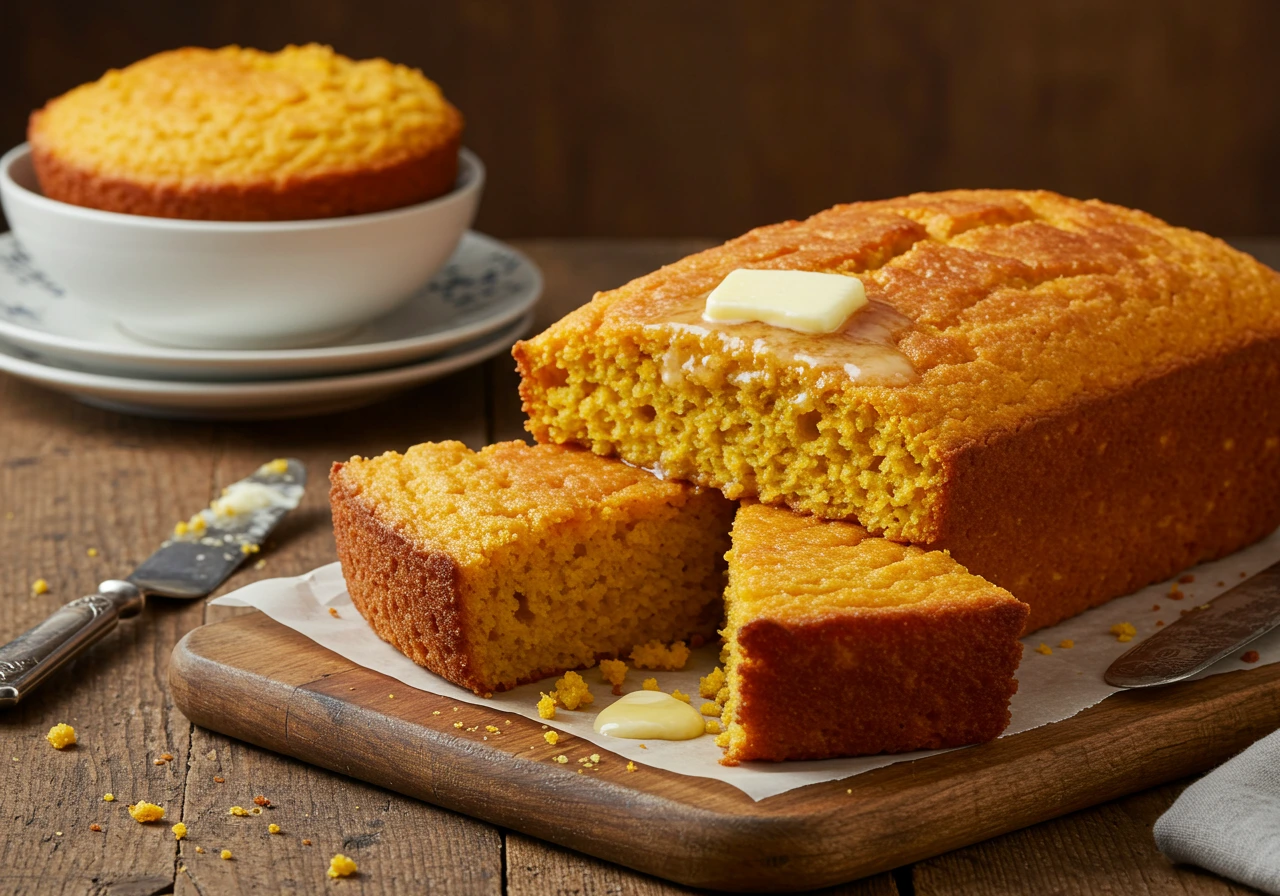Introduction
Cornbread is a classic, comforting staple in Southern cuisine, but adding sweet potatoes elevates it to a whole new level. This sweet potato cornbread recipe combines the rich, natural sweetness of sweet potatoes with the hearty, slightly crumbly texture of cornbread. The result? A moist, flavorful, and slightly sweet dish that pairs perfectly with everything from chili to roasted meats—or just a simple spread of butter.
Whether you’ve never tried sweet potato cornbread before or you’re looking for a way to perfect your recipe, this guide will walk you through every detail. From selecting the right ingredients to achieving the best texture, we’ve got you covered. Let’s start with the essentials: understanding the origins of cornbread and why sweet potatoes make the perfect addition.
Part 1: Introduction and Background
The Origins of Cornbread and Its Southern Roots
Cornbread has deep roots in Southern and Native American cuisine. Originally made from ground corn, it has been a staple for centuries, evolving through different cultural influences. Traditional Southern cornbread is often made without sugar, relying on the rich flavors of cornmeal and buttermilk. However, as cornbread recipes have adapted, variations like honey cornbread, jalapeño cornbread, and sweet potato cornbread have emerged.
Unlike its classic counterpart, sweet potato cornbread introduces a richer, slightly denser texture with a naturally sweet flavor that makes it incredibly versatile. The inclusion of sweet potatoes not only enhances the taste but also increases the nutritional value, making it a healthier option than standard cornbread.
Why Sweet Potatoes Belong in Cornbread
If you’ve ever had sweet potatoes mashed, roasted, or baked into pies, you know how naturally sweet and creamy they are. But why add them to cornbread? Here are some compelling reasons:
- Moisture Boost: Sweet potatoes add moisture, preventing the cornbread from becoming too dry.
- Natural Sweetness: They reduce the need for added sugar while enhancing the depth of flavor.
- Nutritional Benefits: Packed with fiber, vitamin A, and antioxidants, sweet potatoes make cornbread a more wholesome choice.
- Enhanced Texture: They create a soft, tender crumb that’s not too dense yet still hearty.
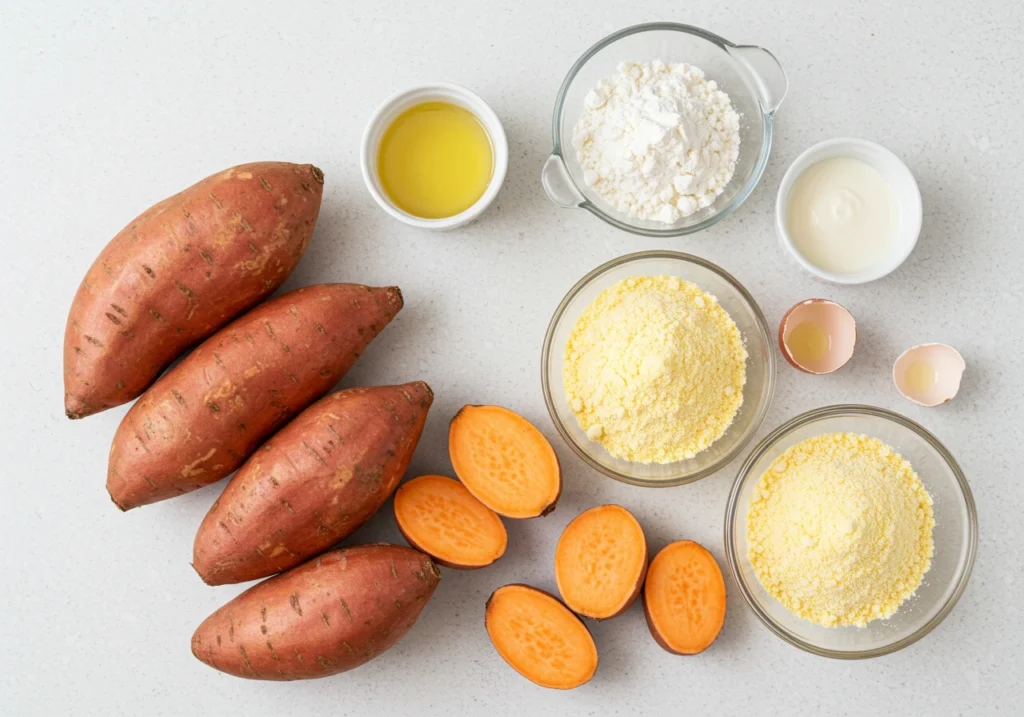
What Makes the Perfect Sweet Potato Cornbread?
Achieving the perfect sweet potato cornbread depends on a few key factors:
- The Right Cornmeal – A fine or medium grind of yellow cornmeal ensures a balanced texture.
- Freshly Cooked Sweet Potatoes – Roasting or steaming them beforehand intensifies their natural sweetness.
- Balanced Wet and Dry Ingredients – A well-mixed batter is key to light, fluffy cornbread.
- Proper Baking Method – Using a cast-iron skillet can give the edges a crisp finish while keeping the inside soft.
The Growing Popularity of Sweet Potato Cornbread
Over the years, sweet potato cornbread has gained popularity beyond the Southern United States. With more people seeking out healthier, gluten-free, or dairy-free alternatives, recipes have evolved to include various adaptations. Some prefer adding cinnamon and nutmeg for warmth, while others incorporate honey, maple syrup, or nuts to enhance the sweetness and texture.
Sweet potato cornbread is no longer just a Southern delicacy—it has become a must-try comfort food for any cornbread lover looking to experiment with flavors. The best part? It’s easy to make, incredibly versatile, and perfect for any occasion.
Part 2: Ingredients and Preparation
Making the perfect sweet potato cornbread begins with the right selection of ingredients and a precise preparation process. Each component plays a crucial role in achieving that moist, slightly sweet, and rich flavor that sets this cornbread apart from traditional versions. In this section, we’ll break down the essential ingredients, the best preparation methods, and baking techniques to ensure you get the best results every time.
Key Ingredients for Sweet Potato Cornbread
Cornmeal Selection
Not all cornmeal is created equal, and the type you choose will significantly impact your cornbread’s texture and flavor.
- Yellow vs. White Cornmeal:
- Yellow cornmeal is slightly sweeter and has a stronger corn flavor, making it a great match for sweet potato cornbread.
- White cornmeal has a milder taste and finer texture, which can result in a softer, more delicate crumb.
- Stone-Ground vs. Regular Cornmeal:
- Stone-ground cornmeal retains more of the corn’s natural oils and nutrients, producing a richer, more textured cornbread.
- Regular cornmeal is more finely processed and provides a smoother consistency.
For this recipe, yellow stone-ground cornmeal is recommended to balance texture and flavor.
Sweet Potatoes
The star ingredient of this recipe, sweet potatoes add natural sweetness, moisture, and a velvety texture to the cornbread.
- Choosing the Right Sweet Potatoes:
- Deep orange-fleshed sweet potatoes (such as Garnet or Jewel varieties) are best for their natural sweetness and creamy texture.
- Avoid dry, pale sweet potatoes, as they lack the richness needed for this recipe.
- Preparation Methods:
- Roasting: This method enhances the natural sweetness by caramelizing the sugars. Simply bake whole sweet potatoes at 400°F (200°C) for about 45 minutes until soft.
- Boiling: While faster, boiling can lead to a slightly waterier texture. Peel, cube, and simmer sweet potatoes for about 20 minutes until fork-tender, then drain and mash.
For the best flavor, roasting is recommended.
Additional Ingredients
Beyond sweet potatoes and cornmeal, several other ingredients contribute to the perfect sweet potato cornbread:
- Flour: A mix of all-purpose flour and cornmeal ensures a tender but structured texture.
- Leavening Agents: Baking powder (and sometimes a pinch of baking soda) helps the cornbread rise.
- Sweeteners: Honey, brown sugar, or maple syrup complement the natural sweetness of the sweet potatoes.
- Fats: Melted butter or neutral oil adds moisture and richness.
- Liquids: Buttermilk or whole milk keeps the batter smooth while enhancing flavor.
Step-by-Step Preparation Guide
Preparing the Sweet Potatoes
- Wash and scrub the sweet potatoes thoroughly.
- If roasting, place them on a baking sheet and bake at 400°F (200°C) until fork-tender. Let them cool, then peel and mash.
- If boiling, peel and cube the sweet potatoes, then cook in boiling water for about 20 minutes until soft. Drain and mash until smooth.
Ensure the mashed sweet potatoes are free of lumps for a smooth batter.
Combining Dry Ingredients
- In a large bowl, whisk together:
- Cornmeal
- Flour
- Baking powder (and baking soda if using)
- Salt
- Cinnamon or nutmeg (optional for warmth)
Mixing these dry ingredients thoroughly helps create an even-textured cornbread.
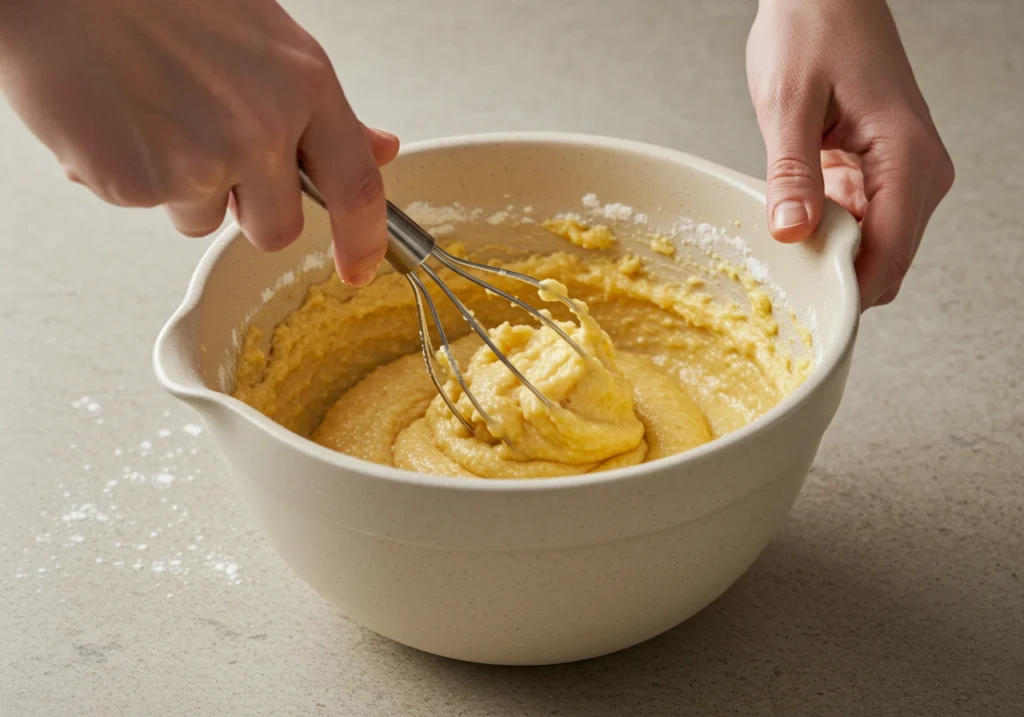
Integrating Wet Ingredients
- In a separate bowl, whisk together:
- Mashed sweet potatoes
- Melted butter or oil
- Eggs
- Milk or buttermilk
- Honey or maple syrup
Blend until smooth and well incorporated.
Mixing and Forming the Batter
- Gradually combine the wet and dry ingredients, stirring gently. Avoid over-mixing, as this can make the cornbread dense.
- The batter should be thick but pourable. If it’s too stiff, add a splash of milk to loosen it.
Once mixed, the batter is ready for baking.
Baking Techniques and Tips
Choosing the Right Bakeware
The choice of bakeware affects the final texture:
- Cast-Iron Skillet: Creates a crisp crust while keeping the inside moist. Preheating the skillet before pouring in the batter enhances the effect.
- Glass Baking Dish: Produces a softer crust with even baking.
- Muffin Tin: Ideal for individual portions with golden edges.
For traditional-style cornbread, a cast-iron skillet is the best option.
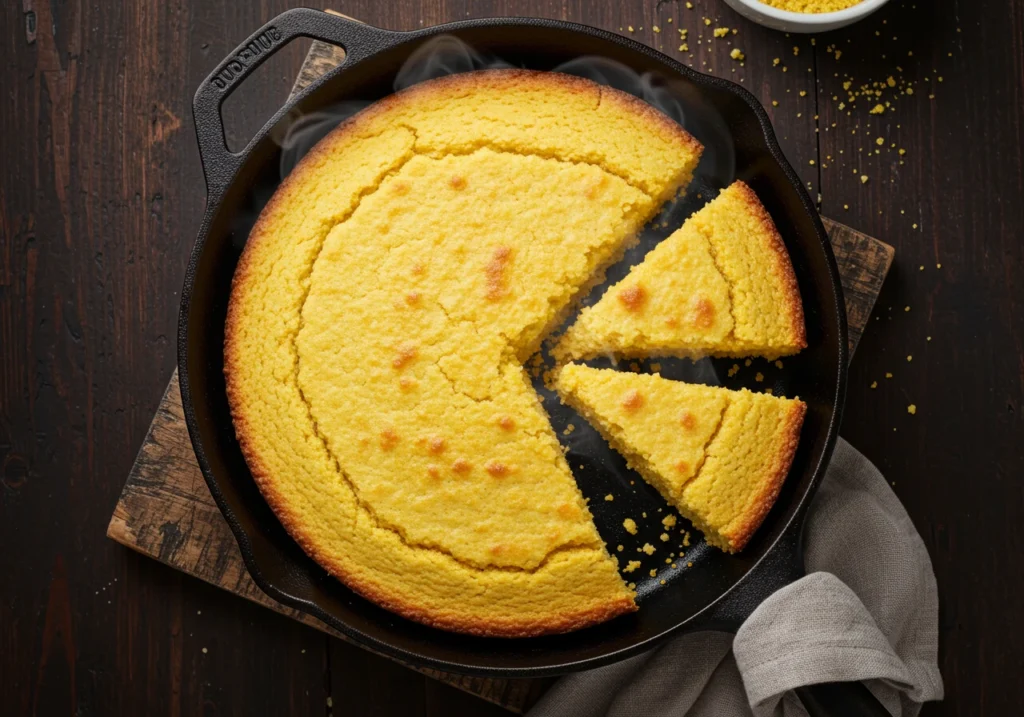
Oven Settings and Baking Duration
- Preheat the oven to 375°F (190°C).
- Pour the batter into the greased baking dish or cast-iron skillet.
- Bake for 25-30 minutes (for a skillet or baking dish) or 15-20 minutes (for muffins).
- The cornbread should be golden brown and slightly pulled away from the edges.
Part 3: Variations and Serving Suggestions
One of the best things about sweet potato cornbread is its versatility. Whether you prefer it savory, sweet, or tailored to dietary needs, there are countless ways to modify this recipe while maintaining its signature moist and fluffy texture. Let’s explore different flavor enhancements, dietary adjustments, and the best ways to serve this delicious dish.
Flavor Variations and Enhancements
Savory Additions
If you enjoy a more savory take on sweet potato cornbread, incorporating ingredients like herbs, spices, and cheese can elevate the flavor:
- Cheesy Twist: Add shredded cheddar, gouda, or pepper jack for a richer taste.
- Herb Infusion: Fresh or dried rosemary, thyme, or chives pair well with the earthy notes of sweet potatoes.
- Spice it Up: A pinch of smoked paprika, cayenne, or black pepper can add warmth and complexity.
- Corn Kernels & Jalapeños: Mixing in roasted corn kernels and chopped jalapeños creates a delicious contrast of sweetness and heat.
These additions make sweet potato cornbread an excellent companion for savory dishes like soups, stews, or grilled meats.
Sweet Modifications
For those who prefer a sweeter version of this cornbread, consider enhancing it with honey, nuts, or dried fruits:
- Natural Sweeteners: Swap granulated sugar with honey, maple syrup, or brown sugar for a richer taste.
- Nutty Crunch: Chopped pecans, walnuts, or almonds add a delightful crunch and depth of flavor.
- Dried Fruit Delight: Cranberries, raisins, or chopped dates bring a chewy texture and fruity sweetness.
- Cinnamon & Nutmeg: These warming spices enhance the natural sweetness of sweet potatoes.
This variation works beautifully as a dessert, breakfast treat, or holiday side dish.
Dietary Adjustments
If you need to modify the recipe for dietary preferences or restrictions, here are some effective substitutions:
- Gluten-Free: Use a 1:1 gluten-free flour blend or almond flour instead of all-purpose flour.
- Vegan: Replace eggs with a flaxseed or chia seed mixture (1 tbsp ground seeds + 3 tbsp water per egg), and use plant-based butter and milk.
- Low-Sugar: Reduce added sugar or opt for unsweetened applesauce as a natural sweetener.
These adjustments allow you to enjoy sweet potato cornbread without compromising on taste or texture.
Serving Suggestions
Pairing with Main Courses
Sweet potato cornbread is the perfect side dish for a variety of meals. Here are some ideal pairings:
- Hearty Chili & Soups: The sweet, slightly dense cornbread balances spicy and savory stews.
- Southern BBQ & Roasts: It complements grilled meats, pulled chicken, or roasted turkey.
- Holiday Feasts: Serve it alongside Thanksgiving turkey, glazed carrots, and stuffing.
- Egg-Based Dishes: Enjoy it with scrambled eggs, omelets, or shakshuka for a comforting breakfast.
The subtle sweetness of sweet potato cornbread makes it an excellent contrast to bold, savory flavors.
Enjoying as a Standalone Dish
Sometimes, sweet potato cornbread is so good that it doesn’t need anything else! Here are some ways to enjoy it on its own:
- For Breakfast: Serve it warm with butter, honey, or jam, or enjoy it alongside yogurt and fresh fruit.
- As a Snack: A quick, satisfying afternoon treat with a drizzle of maple syrup.
- For Dessert: Pair it with whipped cream, caramel sauce, or vanilla ice cream for an indulgent finish.
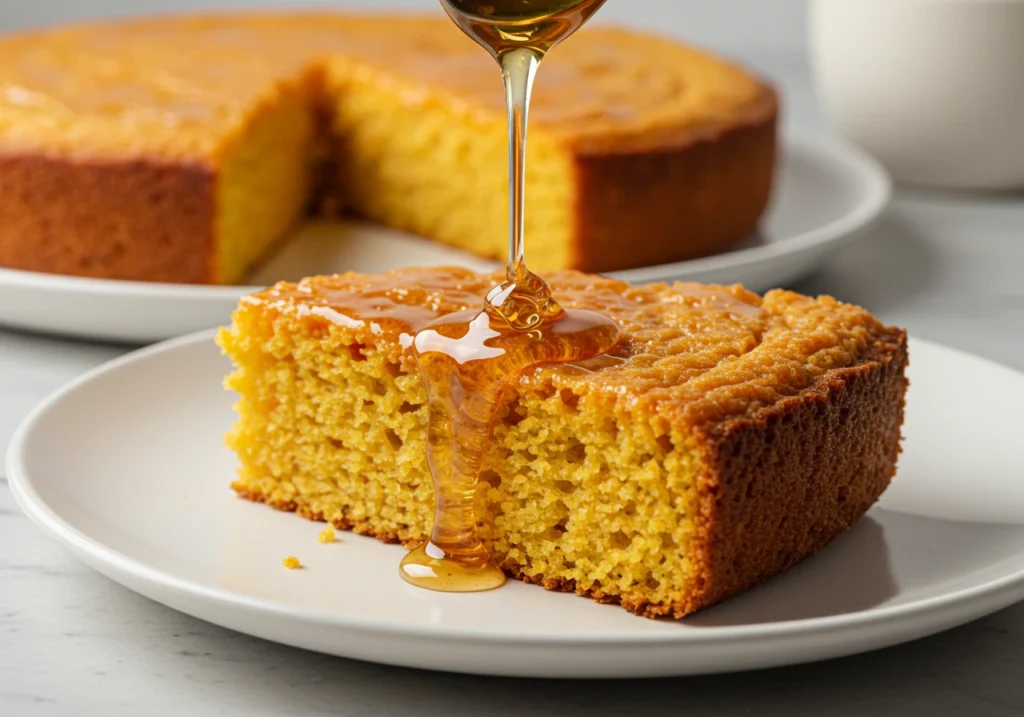
No matter how you serve it, sweet potato cornbread is a flavorful, comforting addition to any meal.
Part 4: Storage, Reheating, and Personal Experience
Making a batch of sweet potato cornbread is always rewarding, but ensuring it stays fresh and delicious requires proper storage and reheating techniques. Whether you plan to enjoy it over several days or freeze some for later, these tips will help preserve its moisture and flavor.
Storage and Reheating Instructions
Short-Term Storage
If you plan to consume your sweet potato cornbread within a few days, proper storage at room temperature will keep it fresh:
- Cool Completely: Before storing, let the cornbread cool completely to prevent excess moisture buildup, which can lead to sogginess.
- Wrap or Cover Well: Store in an airtight container or wrap individual slices in plastic wrap or aluminum foil.
- Room Temperature Duration: Cornbread stays fresh for up to 3 days at room temperature.
- Moisture Retention Tip: If you’re storing it in a container, place a paper towel inside to absorb excess moisture and keep the cornbread from becoming too soft.
For a quick refresh, warm slices in the microwave for 10-15 seconds before serving.
Long-Term Storage
If you want to store sweet potato cornbread for a longer period, freezing is your best option:
- Pre-Freezing: Wrap individual slices in plastic wrap, then place them in a ziplock bag or airtight container.
- Shelf Life: Cornbread stays fresh for up to 3 months in the freezer.
- Thawing Instructions: When ready to eat, remove a slice and let it thaw at room temperature for about 20-30 minutes.
- Reheating for Best Texture:
- Oven Method: Reheat in a 350°F (175°C) oven for 5-10 minutes for a crispy exterior.
- Microwave Method: For a softer texture, heat in the microwave for 20-30 seconds, covering it with a damp paper towel.
These methods preserve the flavor and texture, ensuring your cornbread tastes fresh even after freezing.
Personal Experience: Trying the Recipe
Preparation Process
Making this sweet potato cornbread was an absolute delight! As I started, I opted for roasting the sweet potatoes instead of boiling them—this small step intensified the natural sweetness, making the batter even richer.
The mixing process was straightforward, but I quickly learned that gently folding the dry and wet ingredients together is key. Over-mixing can make the cornbread dense, so I stirred just until combined.
One trick I found incredibly useful was preheating the cast-iron skillet in the oven before adding the batter. This created a perfect golden crust that added a delightful contrast to the moist center. The batter sizzled as I poured it into the hot skillet, filling the kitchen with an irresistible warm, sweet aroma.
Tasting Notes
When I took my first bite, I immediately noticed how moist, soft, and rich the texture was. The sweet potatoes added a delicate sweetness that complemented the natural corn flavor beautifully. Unlike traditional cornbread, which can sometimes be dry, this version had a soft, melt-in-your-mouth quality.
The hint of cinnamon and nutmeg I added brought a gentle warmth that made each bite feel comforting and homey. The crisp edges from the cast-iron skillet provided the perfect balance of textures—slightly crunchy outside, soft and fluffy inside.
Pairing it with a bit of honey butter enhanced the flavors even more, making it feel like a decadent treat rather than just a side dish.
Recommendations
For those attempting this recipe, here are a few must-know tips:
- Roast, Don’t Boil – Roasting sweet potatoes brings out more depth and sweetness.
- Use a Cast-Iron Skillet – This enhances the crust, making the cornbread extra delicious.
- Avoid Over-Mixing – Gently stir to keep the texture light and fluffy.
- Try Different Sweeteners – If you want a slightly deeper caramelized flavor, swap in brown sugar or maple syrup.
- Customize Your Add-Ins – Whether you prefer cheese, jalapeños, or pecans, this recipe is easy to tweak.
This sweet potato cornbread exceeded my expectations—it’s simple, delicious, and incredibly versatile. Whether you serve it sweet or savory, it’s a recipe worth keeping in your rotation.
Part 5: Frequently Asked Questions (FAQs)
There’s a lot to love about sweet potato cornbread, but if you’re new to making it, you might have some questions about its health benefits, variations, and best serving options. Below, we’ll answer some of the most common FAQs to help you get the most out of this delicious recipe.
Is sweet potato cornbread recipe Healthy?
Yes! sweet potato cornbread recipe is a nutrient-rich alternative to traditional cornbread. Thanks to sweet potatoes, it provides fiber, vitamin A, and antioxidants that support immune health and digestion. Using natural sweeteners like honey or maple syrup makes it a better-for-you choice. To make it even healthier, opt for whole grain cornmeal, gluten-free flour, or plant-based substitutes.
What Is the Difference Between Southern Cornbread and Sweet Cornbread?
The biggest difference is sweetness and texture.
- Southern cornbread is savory, often made with little or no sugar, a crispy crust (when baked in cast iron), and a more crumbly texture.
- Sweet cornbread, on the other hand, includes sugar, honey, or maple syrup, making it softer and cake-like.
sweet potato cornbread recipe falls somewhere in between—it has a hint of natural sweetness but remains hearty.
Why Do You Soak Sweet Potatoes Before Baking?
Soaking sweet potatoes before baking is optional but can improve their texture and flavor:
- Removes excess starch, which helps prevent a gummy texture.
- Enhances caramelization, making them sweeter and more flavorful.
- Softens the flesh, reducing baking time.
If roasting whole, there’s no need to soak, but if using cubed or sliced sweet potatoes, soaking for 30 minutes in cold water can improve consistency.
What to Serve with Sweet Potato Cornbread?
This cornbread is incredibly versatile and pairs well with both savory and sweet dishes:
- Savory Pairings: Chili, stews, BBQ chicken, roasted turkey, or collard greens.
- Sweet Pairings: Honey butter, cinnamon sugar, maple syrup, or fresh fruit.
- Breakfast Ideas: Serve it with eggs, yogurt, or a drizzle of honey for a hearty start to your day.
No matter how you serve it, sweet potato cornbread recipe is a delicious addition to any meal!
Part 6: Conclusion
Final Thoughts on Sweet Potato Cornbread
sweet potato cornbread recipe is more than just a simple side dish—it’s a flavorful, versatile, and nutrient-packed twist on a beloved classic. Whether you prefer your cornbread sweet or savory, dense or fluffy, this recipe allows for easy customization to suit any taste or dietary preference. The addition of sweet potatoes not only enhances moisture and natural sweetness but also boosts the dish with fiber, vitamins, and antioxidants, making it a more wholesome alternative to traditional cornbread.
What makes this recipe truly special is its flexibility—you can add cheese and spices for a savory kick, mix in honey and nuts for extra sweetness, or tweak the ingredients to make it gluten-free or vegan. Whether served alongside hearty stews, grilled meats, or enjoyed on its own, this cornbread never fails to impress.
So, if you haven’t tried making sweet potato cornbread recipe yet, now’s the time! Experiment with flavors, test out different add-ins, and find your perfect version. No matter how you make it, one thing’s for sure—this is a comfort food classic you’ll keep coming back to.
Happy baking, and enjoy every warm, buttery bite! 🍞✨

